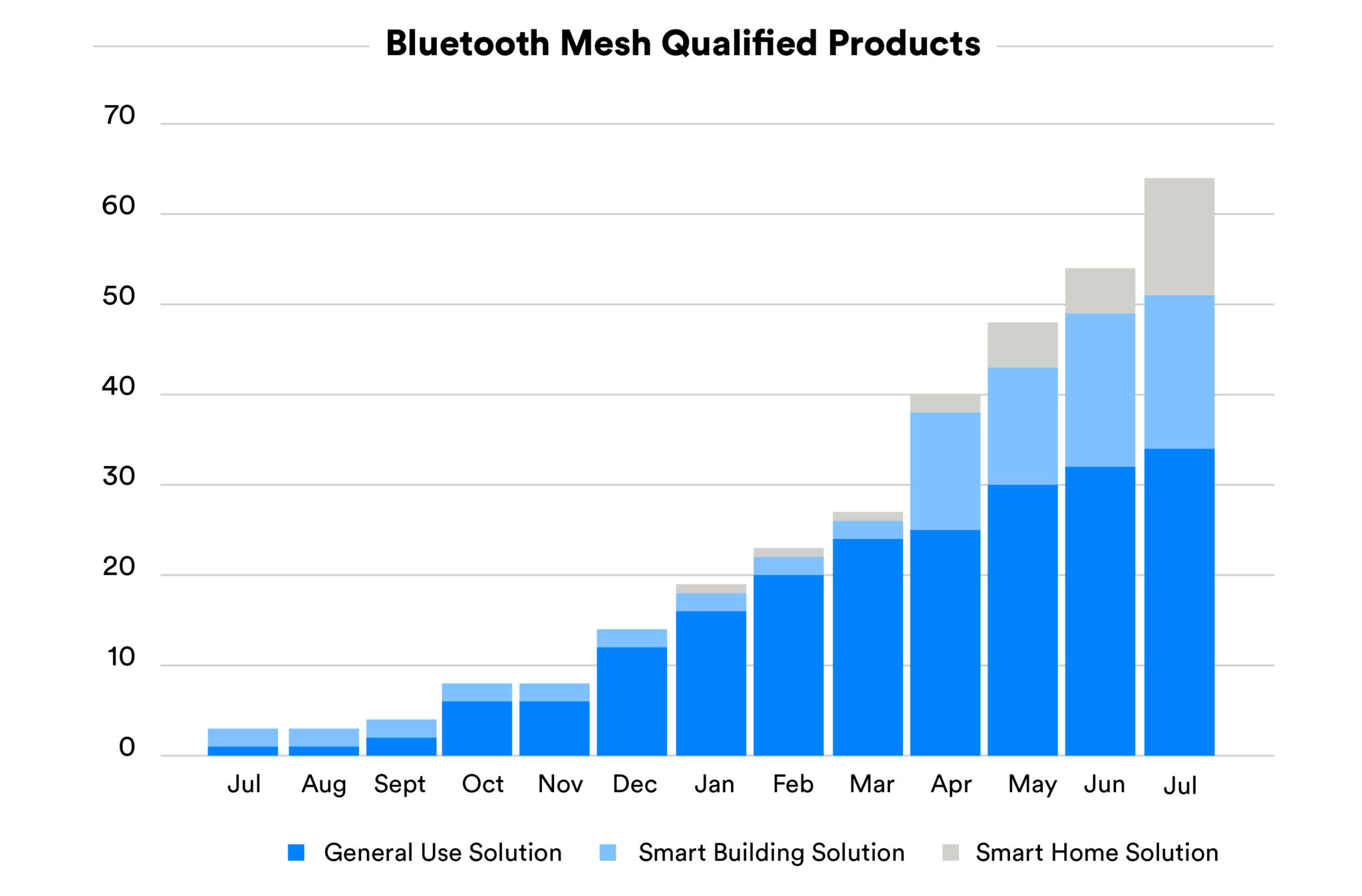It’s been one year since the release of the Bluetooth® Mesh Networking Specifications, and the rate of adoption has exceeded all expectations. Every month, new Bluetooth Mesh Networking products are being introduced that support a wide range of smart solution services for the Internet of Things (IoT) — everything from lighting control to full building automation.
“It is clear that markets always grow when devices from many vendors work together seamlessly,” said Jürgen Schreier from Industry of Things. “The mesh capability of Bluetooth ensures this worldwide interoperability.”
The Bluetooth Qualification Process ensures that all Bluetooth products meet the global interoperability synonymous with Bluetooth. It also gives the Bluetooth Special Interest Group (SIG) visibility into the types of Bluetooth products being developed, which offers insights into various market trends, as well as a unique perspective on the adoption rate of Bluetooth technologies.
With a full year behind us since the launch of Bluetooth Mesh Networking, it’s a fitting time to take a closer look at the complete list of qualified Bluetooth Mesh Networking products and explore what a year’s momentum means for the technology and the markets it impacts.
How many qualified products are there?
There are now 65 qualified Bluetooth® products with mesh networking capability, and the number of new products continues to increase at a dizzying rate.

By comparison, there are alternative mesh technologies released years before Bluetooth Mesh Networking that have only a fraction of that number of qualified products available. In one short year, Bluetooth Mesh has emerged as a leading mesh networking technology with a bright future.
Types of qualified Bluetooth Mesh Networking products
If you drill down deeper into the list of Bluetooth® Mesh Networking qualifications over the last twelve months, and look at the types of Bluetooth Mesh Networking products being qualified, you can see the trend follows a predictable pattern that we tend to see when new Bluetooth capabilities are released.
Lower level enabling technology products, such as Bluetooth software stacks and modules that include mesh networking capability, were amongst the first to be qualified. These were initiated by major Bluetooth stack and module vendors, including Amiccom, Cypress, Jingxun, Iton, Marvell, MindTree, Nordic Semiconductor, Silicon Labs, Silvair, Telink, Toshiba, Xiaomi, and Qualcomm.
Over the last six months, you can see that end products began to be qualified, coming from companies such as Airoha, Alibaba, Danlers, Delta Electronics, LEDVANCE, and Murata.

Qualified Bluetooth Mesh Networking products by target market
Bluetooth® Mesh Networking was designed, from the beginning, to be the first low-power wireless mesh networking solution that meets the strict reliability, scalability, and security requirements of commercial and industrial markets. Upon its release, it was widely believed that adoption of the technology would start in the smart building market — specifically within connected lighting solutions designed for commercial building automation
“The arrival of Bluetooth Mesh will transform lighting into part of the IT network and effectively kill the traditional lighting control box,” said Ray Molony from Lux Review.
As predicted, lighting control systems have served as a key use case driving the increase in Bluetooth Mesh Networking implementations. A building’s lighting system provides a natural grid through which all devices in a Bluetooth Mesh Network can pass messages and establish whole-building control, monitoring, and automation systems within a facility. This wireless lighting solution can also function as a platform to enable indoor positioning and location services — including point-of-interest solutions, indoor navigation, asset tracking, and improved space utilization.
“The Bluetooth SIG sees this as only the beginning, because if you have a home or a workplace where every light-bulb is Bluetooth enabled, this doesn’t just mean you have smart lighting, you have in fact built a building-wide Bluetooth network blanket, which can talk to every other Bluetooth device in the building,” said James O’Malley from Gizmodo UK.
Though designed to meet the high demands of commercial and industrial markets, Bluetooth Mesh Networking easily scales down to meet the requirements of the smart home market. So, it’s no surprise that Bluetooth Mesh Networking also gained early traction in the smart home.

Initial use cases for the smart home this past year centered not only around lighting, but there was also big emphasis on smart speaker solutions for home automation. The availability of home lighting and smart speaker solutions from LEDVANCE/Osram and Alibaba respectively — who have decided to build their home automation strategy around Bluetooth Mesh Networking — confirms early predictions of Bluetooth Mesh Networking’s viability in the smart home.
After one year, evidence of increasing adoption and qualification of Bluetooth Mesh capable products confirms all initial forecasts — from preliminary adoption in smart buildings via connected lighting platforms to viability as a smart home solution. The rate of adoption within these initial use cases also points to the expanding role of Bluetooth in other emerging markets, including smart industry and smart cities.
“The internet of things (IoT) experiments of today are laying the groundwork for the smart infrastructure projects of the future,” said Saqib Shah from Engadget UK. “And, chances are, the smart cities that emerge from those developments will be quietly connected by Bluetooth Mesh Networking.”
See the complete list of qualified Bluetooth® Mesh Networking products, or explore our library of Bluetooth Mesh Networking resources to learn more about the latest Bluetooth Mesh Networking technologies.